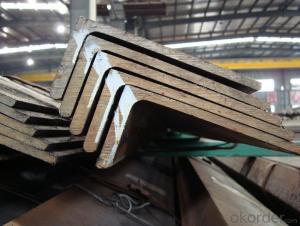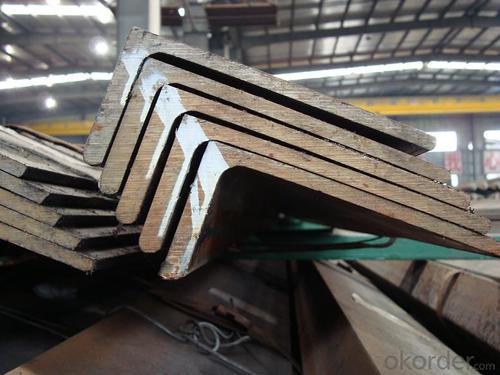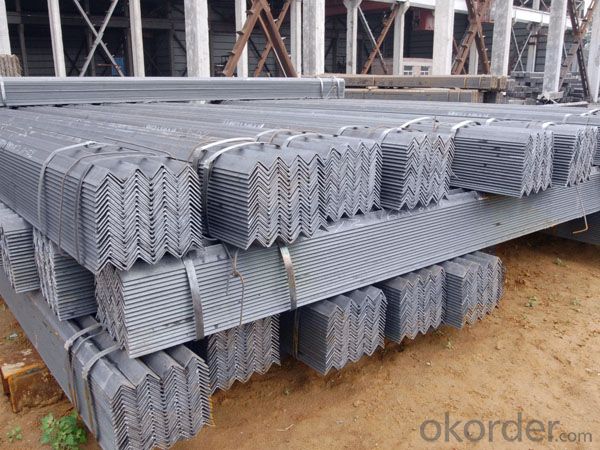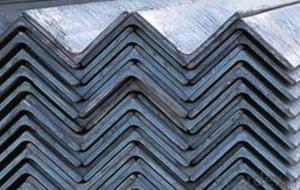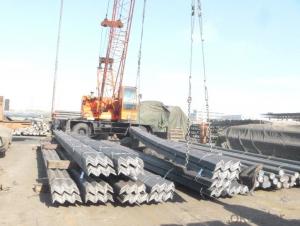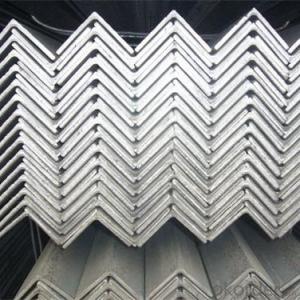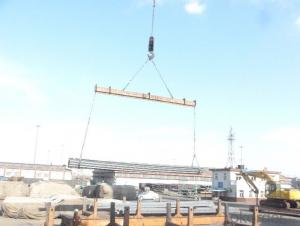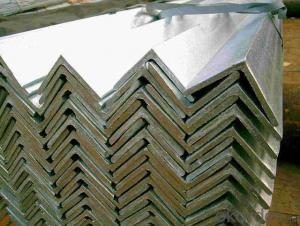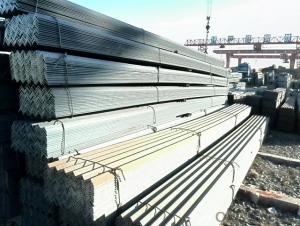Hot rolled equilateral angle steel
- Loading Port:
- China Main Port
- Payment Terms:
- TT OR LC
- Min Order Qty:
- -
- Supply Capability:
- -
OKorder Service Pledge
OKorder Financial Service
You Might Also Like
Angle called angle, strip steel is perpendicular to each other on both sides into angular.There are equilateral angle steel and unequal angle of. Equilateral angle steel two edge widthequal. The specification is expressed by edge width x edge width * thick edge millimeternumber. Such as "front 30 x 30 x 3", namely said equilateral angle steel edge width of 30 mm,3 mm thick edge. Also available models represent models is the edge width, number of centimeters, such as angle 3#. Models of the same model that in the different edge thickness and size, and thus in the contract documents general boundary angle width, edge thick size fill in complete, avoid use alone model said. Hot rolled equilateral angle steel specifications for 2#-20#. Angle according to the different needs of structure composed of a variety of stress components, but also can be used as a component of the connections between the.Widely used in a variety of architectural and engineering structures, such as beams, bridge,tower, lifting the transport machinery, ships, industrial furnace, reaction tower, container frame and warehouse.
Angle profile
Angle according to the different needs of structure composed of a variety of stress components, but also can be used as a component of the connections between the. Widely used
In a variety of architectural and engineering structures, such as beams, bridge, tower, lifting the transport machinery, ships, industrial furnace, reaction tower, container rack, cable channel support, power piping, bus mounting bracket, and warehouse shelves.
Angle is built with carbon structural steel, is a simple section steel steel, mainly used for metalcomponents and the frame of the plant. In use requires a good weldability, plastic deformation and certain mechanical strength. The production of raw materials for low carbon steel billetsteel billets, finished angle for the hot rolling, normalizing or hot-rolled state of delivery.
Type specification
Mainly divided into equilateral angle steel and equilateral angle steel two categories, includingunequal angle can be divided into equilateral equilateral thick and unequal thickness two.
Angle specifications expressed with side length and edge thickness size. At present domesticsteel specifications for 2 - 20 cm in length, number number, the same horn steel often have 2- 7 different edge thickness. The actual size and edge inlet angle marked on both sides of thethickness and indicate the relevant standards. The general length of more than 12.5cm for large angle, 12.5cm - 5cm for the medium angle, length below 5cm for small angle.
Inlet and outlet angle steel orders generally required the use specifications in the main, thesteel is carbon steel grades corresponding. Is the angle in addition to standard number, nospecific composition and performance series. Angle iron delivery length is divided into fixed length, double length two, domestic angle of fixed length of choice scope has 3 9m, 4 12M, 419m, 6 19m four scope according to the specifications of different. Japanese angle length selection range is 6 - 15m.
Section unequal angle height according to the long edge of the width to calculate the scalene angle steel. Refer to section for angular and both sides unequal in length of steel. Is an angleof. Its length from 25mm * 16mm to 200mm * l25mm. From the hot rolling mill and rolling.General specifications for: scalene angle steel angle 50*32-- angle 200*125 thickness of 4-18mm
Unequal angle steel is widely used in all kinds of metal structures, bridges, machinery manufacturing and shipbuilding, building structure and engineering structures, such as beams, bridges, power transmission tower, lifting the transport machinery, ships, industrial furnace, reaction tower, container frame and warehouse etc..
Import and export
China's import and export have a certain angle each batch, mainly imported from Japan andWestern europe. Exports to Hong Kong and Macao, Southeast Asia, the area is mainly on Latin America and Arabia countries etc.. Export production enterprises mainly in Liaoning,Hebei, Beijing, Shanghai, Tianjin and other provinces and cities of iron and steel plant (rolling mill).
Angle for the large variety of imports, small angle and special shape angle, export varieties for the medium angle such as 6, 7, etc..
- Q: Can steel angles be used in framing?
- Yes, steel angles can be used in framing. Steel angles are commonly used in construction for structural support and reinforcement. They are versatile and can be easily welded, bolted, or screwed together to create frames for various applications. Steel angles provide strength and stability to the structure and can be used in framing walls, ceilings, floors, and other structural components. Additionally, steel angles are available in different sizes and thicknesses, allowing for flexibility in design and construction. Overall, steel angles are a popular choice in framing due to their durability, versatility, and structural properties.
- Q: What is the difference between equal and unequal steel angles?
- Structural steel components commonly used in construction and industrial applications include equal and unequal steel angles. The dimensions and properties of these angles are what set them apart. Equal steel angles, also known as L-shaped angles, have sides and angles that are the same. They are frequently employed to provide support and stability in various structures like buildings, bridges, and machinery. The symmetrical load distribution and balanced strength in all directions make them perfect for applications requiring equal support on both sides. In contrast, unequal steel angles have sides and angles that differ. These angles are used when there is a need for uneven load distribution or a specific angle for a particular job. The longer side of the angle typically carries the load, while the shorter side can provide additional support or serve as a connection point. Unequal angles are commonly used in constructing frames, brackets, and supports where uneven load distribution is expected. Both equal and unequal steel angles are made from carbon steel, which offers good strength and durability. They can be either hot-rolled or cold-formed, depending on the manufacturing process. Hot-rolled angles are produced at high temperatures, resulting in a rough surface finish but improved mechanical properties. On the other hand, cold-formed angles are shaped and bent at room temperature, resulting in a smoother surface finish but slightly lower mechanical properties. In conclusion, the main distinction between equal and unequal steel angles lies in their dimensions and load distribution abilities. Equal angles have identical sides and are used for symmetrical load distribution, while unequal angles have different side lengths and are used for uneven load distribution or specific angle requirements. Both types of angles are made from carbon steel and find common usage in construction and industrial applications.
- Q: What is the typical corrosion rate of steel angles?
- The typical corrosion rate of steel angles can vary depending on several factors such as the environmental conditions, the type of steel used, and the presence of any protective coatings. In general, steel angles are susceptible to corrosion due to their iron content. However, with proper maintenance and the application of protective measures, the corrosion rate can be significantly reduced. In mild atmospheres or indoor environments with low humidity and minimal exposure to corrosive agents, the corrosion rate of steel angles can be relatively low, typically ranging from 0.1 to 0.5 mils per year (1 mil is equivalent to 0.001 inches). This slow corrosion rate allows steel angles to maintain their structural integrity over an extended period. However, in more aggressive environments such as coastal areas with high salt content in the air or industrial settings with exposure to chemicals, the corrosion rate can be significantly higher. In these cases, the corrosion rate of steel angles can range from 0.5 to 2 mils per year or even higher. In such environments, it is crucial to implement measures like regular inspection, cleaning, and the application of protective coatings to mitigate the corrosion rate and prolong the lifespan of the steel angles. It is important to note that these corrosion rates are typical estimates, and actual rates may vary based on the specific conditions and factors mentioned earlier. Consulting with a corrosion engineer or utilizing corrosion rate data specific to the environment and steel type can provide a more accurate estimation of the typical corrosion rate for steel angles in a particular situation.
- Q: Are steel angles available in pre-galvanized form?
- Yes, steel angles are available in pre-galvanized form. Pre-galvanized steel angles have been coated with a layer of zinc before being formed into angles. This galvanized coating provides protection against corrosion, making pre-galvanized steel angles ideal for outdoor and high-moisture environments. The pre-galvanized coating also adds a decorative element to the steel angles, giving them a shiny, metallic appearance. Pre-galvanized steel angles are commonly used in construction, infrastructure projects, and various industrial applications where strength, durability, and corrosion resistance are required.
- Q: What are the different types of connections used for steel angles in educational institutions?
- There are several types of connections commonly used for steel angles in educational institutions. These include bolted connections, welded connections, and clip angles. Bolted connections involve using bolts and nuts to secure the steel angles together. Welded connections, on the other hand, involve fusing the steel angles together using heat. Clip angles are small pieces of steel that are used to connect and reinforce the steel angles. Each type of connection has its own advantages and disadvantages, and the choice depends on factors such as the load requirements, cost, and construction method.
- Q: 100 x 100 x 10 equal angle steel, per meter weight?
- The weight of each metre is 15.120kg 8*15.120=120.96kgMethod for calculating weight of angle iron:Weight per meter =0.00785* (edge width + edge width - side thickness) * edge thicknessAngle called angle, the steel strip is perpendicular to each other on both sides into the corner. There are equal angles and unequal angles. Equilateral angle steelThe two sides are equal in width. Its specifications are edge width * edge width * edgeA thick millimeter representation.
- Q: What is the typical corrosion rate of galvanized steel angles?
- The typical corrosion rate of galvanized steel angles can vary depending on various factors such as environmental conditions, exposure to corrosive agents, and maintenance practices. However, galvanized steel angles generally have a corrosion rate of less than 1 micron per year, making them highly resistant to corrosion compared to other unprotected steel materials.
- Q: What are the different surface finishes available for galvanized steel angles?
- There are several different surface finishes available for galvanized steel angles. 1. Smooth: This is the most common surface finish for galvanized steel angles. It provides a smooth and polished appearance, making it suitable for a wide range of applications. 2. Matte: Matte finish is achieved by applying a chemical treatment to the galvanized steel angles. This finish provides a non-reflective surface, making it ideal for applications where glare is a concern. 3. Textured: Textured finish involves adding a textured pattern to the surface of the galvanized steel angles. This can be done through embossing or by applying a textured coating. The textured surface enhances grip and provides a decorative element. 4. Powder coated: Galvanized steel angles can also be powder coated, which involves applying a dry powder to the surface and then curing it in a high-temperature oven. Powder coating offers a durable and attractive finish, with a wide range of color options available. 5. Painted: Another option is to paint the galvanized steel angles. This can be done using either oil-based or water-based paints. Painting adds an extra layer of protection against corrosion and can be customized to match specific color requirements. Overall, the choice of surface finish for galvanized steel angles depends on the intended use, aesthetic preferences, and the level of protection required against corrosion. It is important to consider the environmental conditions and the specific needs of the application when selecting a surface finish.
- Q: How do steel angles resist bending or deflection?
- Steel angles resist bending or deflection due to their shape and material properties. The L-shape of steel angles provides structural rigidity, preventing excessive bending or deflection under load. Additionally, the high tensile strength and stiffness of steel as a material enable angles to withstand external forces and distribute them evenly, ensuring minimal bending or deflection.
- Q: What are the design standards for steel angles?
- The specific application and industry requirements determine the design standards for steel angles. However, in the construction and engineering fields, there are commonly followed general design standards. The dimensional and mechanical properties of the steel angles are an important aspect. These properties encompass the angle's size, thickness, length, and weight. Typically, the dimensions are specified in millimeters or inches, while the mechanical properties determine the angle's strength and load-bearing capacity. Steel angles usually have an L-shaped shape, with legs that can be equal or unequal in length. Equal-legged angles have two legs of the same length, while unequal-legged angles have two legs of different lengths. The shape and geometry of the angle play a critical role in determining its structural integrity and stability. Another crucial consideration is the material specification for the steel angles. The material used for fabrication must meet specific standards, such as those set by the American Society for Testing and Materials (ASTM). This ensures the required strength, ductility, and toughness. Carbon steel, stainless steel, and alloy steel are commonly used materials for steel angles. Connection details are also included in the design standards for steel angles. These details specify how the angles are connected to other structural members, such as beams, columns, or plates. The connection method ensures proper load transfer and structural stability. It may involve welding, bolting, or other mechanical fastening methods. Furthermore, design standards may provide guidelines for the design of steel angle members subjected to specific loads, such as axial compression, bending, or shear. These guidelines include formulas, charts, and design tables that allow engineers to calculate the required size and strength of the angle based on the applied loads and other factors. In conclusion, the design standards for steel angles ensure that these structural members meet specific requirements in terms of dimensions, material properties, shape, and connection details. These standards are crucial for ensuring the safety, reliability, and performance of steel angles in various applications, ranging from building construction to industrial machinery.
Send your message to us
Hot rolled equilateral angle steel
- Loading Port:
- China Main Port
- Payment Terms:
- TT OR LC
- Min Order Qty:
- -
- Supply Capability:
- -
OKorder Service Pledge
OKorder Financial Service
Similar products
Hot products
Hot Searches
Related keywords
